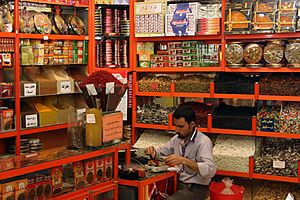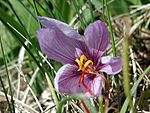Saffron trade facts for kids
Saffron is one of the world's most expensive spices. It comes from tiny parts called stigmas found inside a special flower known as the saffron crocus (its scientific name is Crocus sativus). These flowers don't grow wild in nature. The dried "threads" of saffron have a bitter taste, a smell like hay, and a slight metallic hint.
Scientists believe the saffron crocus first grew in Southwest Asia, possibly in Iran. Other places like Greece, Turkey, and Kashmir might also be where it started. For a long time, saffron has been grown in a wide area from the Mediterranean Sea all the way to Kashmir and China. Today, the main places that grow saffron are Iran, Spain, Kashmir, and Greece.
In recent years, saffron farming has also started in places like New Zealand, Tasmania, and California. Iran grows most of the world's saffron, about 90–93 percent each year.
Contents
Where Saffron Grows
Almost all saffron grows in a region stretching from the Mediterranean Sea in the west to the mountains of Kashmir in the east. Other continents, except Antarctica, grow smaller amounts. In 1991, about 300 t (300,000 kg) of saffron threads and powder were collected each year. About 50 t (50,000 kg) of this was the best quality, called "coupe" saffron.
Top Saffron Producers
- Iran: Iran is the biggest saffron producer by far. In 2019, it grew 430 tons. Most of Iran's saffron is sold to other countries. The main areas for growing saffron in Iran are in the Khorasan Province. Even with some trade challenges, Iran still sells a lot of saffron. Much of it goes to Turkey and Spain, where it is checked for quality and then sold around the world. In 2020/21, saffron production went down because the Covid-19 pandemic made it hard for farmers to harvest the flowers.
- Kashmir: Kashmir is the second largest producer. In 2019, it grew 22 tons. Most of Kashmir's saffron comes from the Pampore area, which has the best weather for it. Kashmir saffron is famous worldwide. People use it in cooking, cosmetics, and for health reasons. It's a big part of Kashmiri culture. Kashmir saffron has long, thick, deep-red threads. It smells strong, tastes a bit bitter, and is processed without chemicals.
* There are three main types of Kashmir saffron: * Lachha Saffron: Stigmas are separated from flowers and dried. * Mongra Saffron: Stigmas are separated, dried in the sun, and processed in the traditional way. * Guchhi Saffron: Similar to Lachha, but the dried stigmas are tied together in a bundle.
- Greece: Greece is the third largest producer.
- Other Countries: Afghanistan, Morocco, and Spain also grow a lot of saffron. Afghanistan has started growing it again recently. Some small amounts are grown in places like Austria, England, Germany, Switzerland, Tasmania, China, Egypt, France, Israel, Mexico, New Zealand, Turkey (especially Safranbolu), California, and Central Africa.
Some saffron growing regions have special protection. For example, the European Union protects saffron grown in La Mancha, Spain; L'Aquila, Italy; and around Kozani, Greece. In Kashmir, there's a group called the All J&K Saffron Growers & Dealers Association that helps saffron farmers and promotes fair trade.
Why Saffron is Expensive
How Saffron is Harvested
Saffron costs a lot because it's very hard to collect. The tiny stigmas must be picked by hand from each crocus flower. You need a huge number of flowers to get even a small amount of saffron.
To get just 1 lb (0.45 kg) of dry saffron, farmers need to harvest about 50,000 to 75,000 flowers! This is like picking flowers from an area the size of a football field. All these flowers bloom at the same time, but only for a short period. This means farmers have to work very quickly and intensely for about 40 hours over one or two weeks, sometimes even day and night.
After picking, the stigmas must be dried fast so they don't spoil or get moldy. Traditionally, they are spread on screens and baked over hot coals or in ovens at temperatures of 30–35 °C (86–95 °F) for 10–12 hours. Once dry, the saffron is stored in airtight glass containers.
Saffron Prices
Because it's so hard to produce, saffron is very expensive. In 2015, prices could go up to $65 per gram. In Western countries, the average price for a pound of saffron can be around US$1,000.
Even though it's expensive, you only need a tiny bit of saffron for cooking or medicine. A pound of saffron contains between 70,000 and 200,000 threads. Saffron is sometimes said to cost more per weight than gold!
Buying Saffron
When buying saffron, experienced buyers look for bright red threads that are a little moist and stretchy. They avoid dull, brick-red threads, which mean the saffron is old and dry. It's best to buy saffron from the current harvest year. Good sellers will tell you the harvest year, like "2002/2003."
Saffron's Future
Saffron use is expected to grow worldwide, from about $944 million in 2019 to $1.6 billion by 2027. This is especially true for its use in cosmetics, hair care products, and dietary supplements. Saffron is also becoming more popular as a natural coloring in ethnic cooking and for textiles. Because it's hard to get enough saffron and production costs are high, prices will likely go up as the demand for saffron almost doubles in the next ten years.




